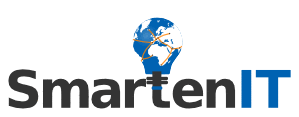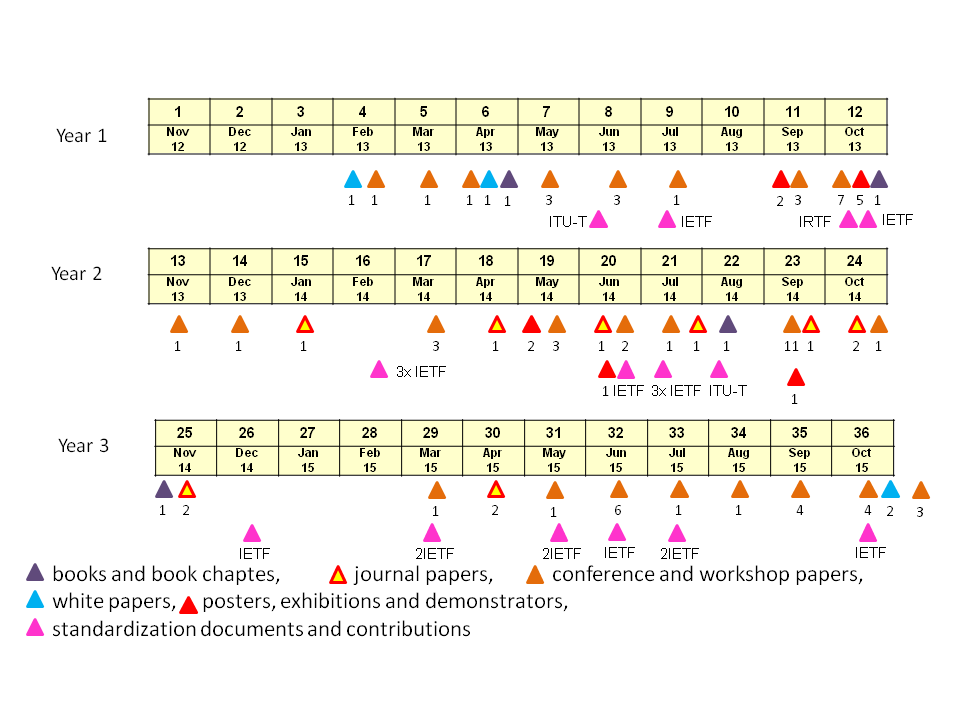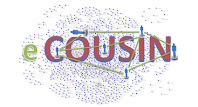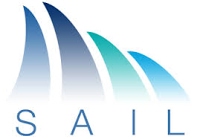Dissemination, Exploitation, and Liaisons
WP5 aims at defining SmartenIT’s strategies and plans for external liaisons, dissemination, and exploitation of the project's results, as well as support relevant standardizations in fields relevant to SmartenIT. Driven by the set of identified key project assets, the determined external liaisons strategy and plan answer with whom to engage/co-operate, the dissemination strategy and plan answer what to communicate (and how/where), and the initial exploitation plan answer when to exploit what and by whom.
Executive Summary from D5.4 "Final Report on Liaisons, Standardization, and Dissemination" covering WP5 results over total project time of SmartenIT:
At the beginning of the project, D5.1 and D5.2 were produced in order to introduce the full set of four WP5 working fields (exploitation, standardization, external liaisons, and dissemination). Deliverable D5.4 reports the SmartenIT project's achievements during its 3-year lifetime done within the scope of external liaisons, standardization and disse-mination. This deliverable, considered jointly with D5.3 , reporting both industrial and academic partners’ exploitation measures, they give final and concise vision of different kinds of already published and exploited results.
This document thoroughly overviews: - Involvement of partners in standardization institutions and forums alongside with detailed reporting of achieved results;
- External liaisons - with 9 external projects were established. The following 6 projects were selected initially in preliminary Phase 1 of the external liaisons plan:
- eCousin (enhanced COntent distribUtion with Social Information);
- FLAMINGO (Management of the Future Internet);
- Lightness (Low latency and high throughput dynamic network infrastructures for high performance datacenter interconnects);
- Novi (Networking Innovation Over Virtualized Infrastructures);
- SAIL (Scalable and Adaptive Internet Solutions);
- STAR (SwiTching And tRansmission);
- External liaisons with 3 more projects established during project's runtime:
- SIGMONA (SDN Concept in Generalized Mobile Network Architectures);
- Fed4FIRE: Fed4FIRE is an Integrating Project under the European Union’s Seventh Framework Programme (FP7) addressing the work programme topic Future Internet Research and Experimentation (2012-2016);
- FELIX (FEderated Test-beds for Large-scale Infrastructure eXperiments);
- All considered dissemination categories with detailed information about achieve-ments, The project has used different types of dissemination channels: starting from typical papers submitted to conferences (with presentations) and journals, with book chapter and books, to online reporting done by dedicated SmartenIT web page. The project compiled also white papers in order to share general visions of assumptions and solutions for chosen, specified and implemented TM solutions.
Reported achievements of different kinds allow to draw the conclusions that SmartenIT project was very successful in disseminating results via different channels and also in setting up strong and long lasting external liaisons allowing mutual exchange of knowledge, software and many other assets with external consortia.
DisseminationThe dissemination of project results is targeted at research community, industrial community, and academia community, as well as general audience.
Conferences and journals are an important way to disseminate scientific knowledge, and SmartenIT also followed this approach, by publishing its results. All SmartenIT partners participate on presenting papers to several conferences and journals. The results of these contributions have been collected during the first year of the project, the majority being identified in the SmartenIT website. Several editions of the major conferences were targeted. In total, until end of second project year (October 2014), SmartenIT published:
- 18 (+1) project deliverables
- 9 journal papers
- 70 scientific papers published and presented at conferences and workshops
- 5 books and book chapters
- 4 white papers
One of the SmartenIT project achievements - a specification of DTM traffic management mechanism was also presented at RIPE 68 meeting in RACI BoF Session ( Warsaw, Poland, May 12-16, 2014).Graphically, the statistics of publications in first two project years are presented below. The full list of publications can be found here.
SmartenIT publications cover all areas of research and development done in the project. The author graph presented below not only shows the number of papers related to main project topics but also proves the high collaboration in the project.
SmartenIT team members also participate in concentration events and initiatives gathering researchers and experts involved in other projects and interested in similar subjects. We are also involved in organization of events such as workshop, conferences and special tracks.
SmartenIT also disseminates the results to a general public (including non-technical audience) by setting up project web-page, creating social networking, preparing project leaflets and/or press releases and contacts with media. University partners address the academia community by organizing training courses for students and offering project-related Master and doctoral theses.
External Liaisons SmartenIT’s external liaisons strategy was shaped considerably by the set of key project assets determined and described in deliverable D5.1. In particular, the selection of target projects was driven by the strategy’s objectives that – by joint research interest to investigate the interplay of over- and underlays – SmartenIT and/or a target project could profit from liaising in several areas. A thorough assessment of candidate projects resulted in the many European projects being selected as target projects for external liaisons:
eCOUSIN: https://ecousin.cms.orange-labs.fr/- Scope: Social awareness, joint organization of SETM workshop
- Related WPs in SmartenIT: WP1, WP2, WP5
Fed4FIRE: http://www.fed4fire.eu/- Scope: Cloud federation, joint proposal for working session in FIA Athens 2014
- Related WPs in SmartenIT: WP2, WP5
FELIX: http://www.ict-felix.eu/- Scope: Cloud federation, joint proposal for working session in FIA Athens 2014
- Related WPs in SmartenIT: WP2, WP5
FLAMINGO: http://www.fp7-flamingo.eu/- Scope: Socio-economics of future networks technology, authentication/authorization issues for data access
- Related WPs in SmartenIT: WP1, WP2, WP5
LIGHTNESS: http://www.ict-lightness.eu/
- Scope: Scenarios, use-cases, data center focused
- Related WPs in SmartenIT: WP1, WP2
NOVI: http://www.fp7-novi.eu/- Scope: Software implementation platform and tools, test-bed testing experiences, experiment definition
- Related WPs in SmartenIT: WP3, WP4
SAIL: http://www.sail-project.eu/- Scope: Scenarios, use-cases, stakeholders relationship, analysis and business modelling
- Related WPs in SmartenIT: WP1, WP2
SIGMONA: http://celticplus.eu/Projects/Celtic-Plus-Projects/2012/SIGMONA/sigmona-default.asp- Scope: Scenarios, use-cases, stakeholders relationship, analysis and business modelling
- Related WPs in SmartenIT: WP1, WP2
STAR: http://www.starproject.org.uk/index.html
- Scope: Inter-layer mechanisms, stakeholder, analysis, performance and reliability evaluation
- Related WPs in SmartenIT: WP1, WP2
The cooperation with the projects had/has many forms starting from identification of common research areas and interests, through exchanging the knowledge and experience, preparing the joint papers, up to promoting joint standardization activities. Key events and publications were the following once:- Y1: Joint SmartenIT/ECOUSIN Workshop on Social-aware Economic Traffic Management for Overlay and Cloud Applications “SETM”, which was collocated with the 9th International Conference on Network and Service Management (CNSM) held in Zurich, October 14-18, 2013.
- Y2: ITU-T Recommendation Y.3013: Socio-economic Assessment of Future Networks by Tussle Analysis (pdf)
StandardizationSmartenIT pertners follow main standardization bodies as well as contribute to standardization. This a way to disseminate of major project results and to approach the industrial community.
The set of bodies which appeared to match with a number of emerging standardization groups that are boosted by the same reasons than the ones motivating SmartenIT have been determined. This is the case for working and research groups such as IETF (ALTO, CDNI), IRTF (ICNRG, SDNRG), ITU-T (SG13), OGF (NML, NSI), closely connected to the SmartenIT objectives.
Measurable outcomes are Recommendations, RFCs, and patents: ITU-T Recommendation Y.3013 (formerly Y.FNsocioeconomic): Socio-economic Assessment of Future Networks by Tussle Analysis (pdf)
SmartenIT has contributed to standardization preparing the following documents that are updated regularly:- IETF Internet Draft: DTLS-based Security with two-way Authentication for IoT (Tracker)
- IETF Internet Draft: X.509 Public Key Infrastructure Certificates for the Constrained Application Protocol (CoAP) (Tracker)
- IETF Internet Draft: ALTO Traffic Engineering Cost Metrics (Tracker)
- IETF Internet Draft: Two-way Authentication for IoT (Tracker)
- IETF Internet Draft: ALTO Cost Calendar (Tracker)
- IETF Internet Draft: Multi-Cost ALTO (Tracker)
- IRTF ICNRG Baseline Scenarios draft
EU Patents
The following 4 patent applications have been filed in the framework of SmartenIT by ALBLF between June 2013 and February 2014. Four of these applications have been published by the EU Patent Office in December 2014 and January 2015.
Patents applications 1 and 2 are about the ALTO Quality Aggregation System (AQAS) TM mechanism presented in D2.2. They claim and specify how QoE results can be collected and integrated in an ALTO Server database to select application paths and endpoints.
Patents applications 3 and 4 are about the MUCAPS TM mechanism presented in D2.2 and described in D2.4 and D3.3. 4 and 5 claim and specify how the application paths and endpoints selection metrics can be automatically identified w.r.t. configuration parameters such as application, access type and time where as 5 focuses on the in-network deployment of the Multi-Access and Cost AltO (MACAO) decision bloc and related communication interfaces.
Patent list:
- "Methods And Systems For Monitoring The Quality-Of-Experience Of An Application Available Over A Network", KERBOEUF Sylvaine, RANDRIAMASY Claire Sabine, FAUCHEUX FrÈderic, filed June 3rd 2013, country: EU. European Patent Application: EP2811692 A1, European Patent Publication: EP 2811692 A1 20141210
- "Methods And Systems For Providing Alto Metrics Reflecting Application Endpoint Performances", RANDRIAMASY Claire Sabine, FAUCHEUX FrÈderic, KERBOEUF Sylvaine, filed June 3rd 2013, country: EU. European Patent Application: EP 2 811 719 A1, European Patent Publication: EP 2811719 A1 20141210
- "Automated application metric selection for Multi-Cost ALTO queries", RANDRIAMASY Claire Sabine, LAFRAGETTE Jean-Luc, filed July 19th 2013. European Patent Application: EP2827557 A1. European Patent Publication: EP 2827557 A1 20150121
- "Automated metric weight tuning for Multi-Cost ALTO queries", RANDRIAMASY Claire Sabine, LAFRAGETTE Jean-Luc, filed July 19th 2013, country: EU. European Patent Application: EP 13306043 A 20130719. European Patent Publication: EP 2827558 A1 20150121
Organization and support of eventsProject partners organized the following workshops and special sessions during the project duration:
- Special session on “Privacy, Trust, Regulation, and Legal Issues“ at NOMS 2014, May 5-9, 2014, Krakow, Poland
-
Future Internet Assembly (FIA) Athens 2014 session: "Cloud Federations and SDN / NFV", 18-20 March 2014, Athens, Greece
|









